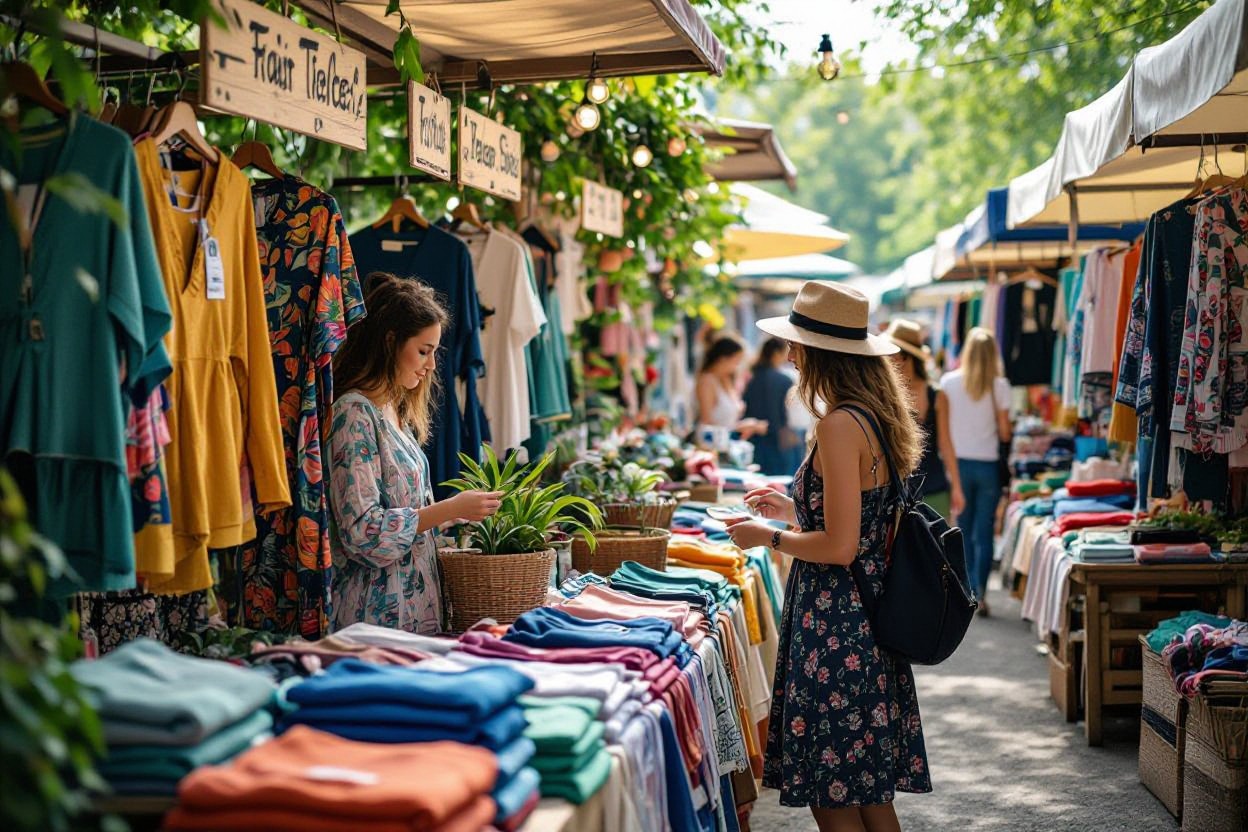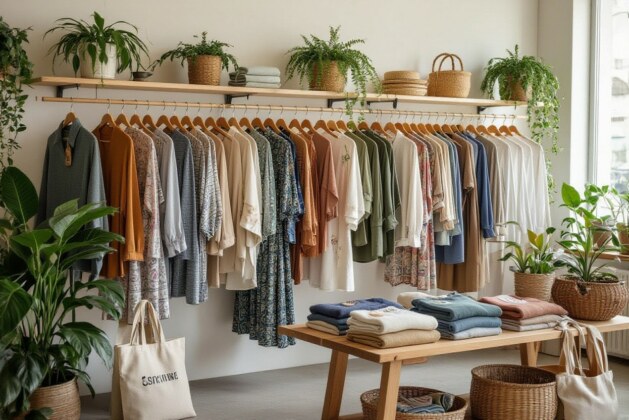The Evolution of Style: Tracing the Roots of Sustainable Fashion
Exploring the history of sustainable fashion reveals its deep-seated connection to traditional craftsmanship and resourcefulness. In the early 20th century, garments were commonly repaired and repurposed due to limited resources, a stark contrast to today’s fast-fashion culture. Brands like Patagonia and Stella McCartney pioneered integrating environmental ethics into design by the late 1990s, proving that style and sustainability can coexist. I find it fascinating how zero-waste patterns and organic textiles today echo these early principles, demonstrating that sustainable fashion is less about new invention and more about rediscovering values we once embraced.

The Eco-Critical Lens: Analyzing the Environmental Impact of Fashion
Digging deeper into fashion’s environmental footprint reveals significant challenges tied to production and consumption patterns. From textile manufacturing to disposal, each stage drains natural resources and generates pollution. The hidden costs of seemingly affordable clothing reframe the conversation, showing that sustainability demands more than trend-driven choices. I find that evaluating fashion through this eco-critical lens uncovers not just immediate impacts but systemic issues, encouraging us to rethink how we shop, wear, and discard garments.
Fast Fashion’s Carbon Footprint
Fast fashion contributes nearly 10% of global carbon emissions, exceeding those of international flights and shipping combined. Brands rush collections, relying on synthetic fibers like polyester, which emit considerable greenhouse gases during production and decomposition. Lower-quality materials and rapid turnover accelerate waste, amplifying environmental strain. Recognizing these figures makes clear that opting out of fast fashion isn’t just about style—it’s a direct action to reduce your carbon footprint.
Resources Depletion and Waste Generation
Textile production consumes vast amounts of water and energy; for instance, producing one cotton shirt requires approximately 2,700 liters of water. Additionally, fashion generates over 92 million tons of waste annually, much of which ends up in landfills or incinerators. Synthetic fabrics exacerbate pollution by releasing microplastics during washing. This cycle of depletion and waste challenges the sustainability of current industry practices and urges consumers to seek durable, responsibly sourced garments.
Beyond water use, cotton farming heavily relies on pesticides and fertilizers, which harm ecosystems and diminish soil health. Synthetic fibers, although less water-intensive, depend on fossil fuels, impacting climate change. Waste management remains a significant hurdle; less than 1% of clothing is recycled into new apparel, while incineration and dumping release toxins and greenhouse gases. This compounding effect of resource depletion and waste highlights why transitioning toward circular fashion models and conscientious purchasing habits can make a profound difference in environmental preservation.

Conscious Choices: Key Principles of Sustainable Fashion
Making mindful decisions about what you wear goes beyond style—it’s about the planet and people behind those clothes. Focusing on durability, minimal environmental footprint, and transparency in production processes helps you invest in garments that align with sustainable values. By prioritizing brands committed to reducing waste and pollution, you’re supporting an industry shift towards more responsible consumption. This approach encourages you to consider the whole lifecycle of your clothing, from sourcing to disposal, transforming shopping into an act of conscious stewardship.
Understanding Eco-Friendly Materials
Materials like organic cotton, bamboo, hemp, and recycled polyester drastically reduce environmental impacts due to organic growing methods or repurposing waste. These fabrics typically require less water, fewer pesticides, and emit fewer greenhouse gases compared to conventional textiles. For instance, organic cotton uses up to 91% less water than traditional cotton cultivation. Exploring blends that incorporate natural fibers can also enhance biodegradability without sacrificing quality, helping your wardrobe contribute less to landfill waste while maintaining wearability.
Ethical Labor Practices and Fair Trade
Supporting brands that enforce fair wages, safe working conditions, and workers’ rights directly impacts the livelihoods of garment workers worldwide. Certifications like Fair Trade and SA8000 provide assurance that your clothing was made without exploitation or unsafe environments. I’ve found that companies with transparent supply chains and third-party audits often showcase their commitment to ethical labor on their websites, enabling you to make informed purchases that respect both people and the planet.
Diving deeper into ethical labor, it’s eye-opening to see how many sweatshops still exist globally, often with workers earning below minimum wages and lacking basic safety. Fair Trade certification not only ensures fair pay but also promotes community welfare, such as access to healthcare and education for workers’ families. Brands like Patagonia and People Tree actively engage in these practices, reinvesting profits into improving factory conditions and empowering workers. Your choice to buy from such companies supports systemic change that uplifts entire communities, turning your shopping decisions into acts of social justice.
Navigating the Market: Tips for Eco-Conscious Shopping
Choosing sustainable fashion means scrutinizing brands and products for their ethical and environmental commitments. I look for certifications like GOTS or Fair Trade, which verify organic materials and fair labor. Shopping locally or from brands with transparent supply chains cuts down on emissions. Opting for quality over quantity helps extend the wardrobe’s life. Resale or rental platforms also support reducing waste and promoting reuse. Perceiving fashion as a lasting investment rather than disposable goods shifts the market towards a more sustainable future.
Identifying Sustainable Brands
To spot brands genuinely committed to sustainability, I focus on transparency about sourcing and production methods. Brands that openly share details about their supply chains, use eco-friendly materials like organic cotton or recycled fibers, and have clear labor standards typically stand out. Certifications from recognized bodies like B Corp or OEKO-TEX lend further credibility. Some brands actively contribute to environmental causes or have repair programs, which reflects deeper dedication. You can often find sustainable labels by researching brand stories and customer reviews online.
Assessing Product Lifespan and End-of-Life Options
Evaluating a product’s durability and what happens after its useful life is key to sustainable shopping. Natural fibers such as wool, hemp, or linen tend to last longer and biodegrade better than synthetics. Some brands design clothing for easy repair or offer take-back and recycling programs, extending the garment’s usefulness. Perceiving the afterlife of your clothing encourages choices that minimize landfill waste and encourage circularity.
Beyond initial durability, assessing end-of-life options involves checking if a garment can be easily recycled or composted. Several companies now incorporate take-back schemes where worn-out clothes are collected and transformed into new textiles, reducing raw material consumption. Understanding these processes helps you support brands that embrace circular economy principles rather than those relying solely on linear production. Knowing your clothing’s full lifecycle builds a personal commitment to sustainability.

Beyond the Purchase: The Role of Consumer Advocacy
Taking your commitment to sustainable fashion a step further means pushing for systemic change. I see that consumer voices have real power to influence brands and policies when they band together. By demanding transparency, fair labor practices, and environmental accountability, you help create an industry that prioritizes ethics over fast fashion’s shortcuts. Whether it’s signing petitions or supporting watchdog organizations, advocacy amplifies the impact of your eco-conscious shopping choices and helps dismantle harmful norms from within.
Supporting Circular Economy Initiatives
Participating in circular fashion systems not only extends the life cycle of garments but also reduces waste dramatically. Initiatives like clothing rental services, repair workshops, and resale platforms promote reusing and recycling materials. When you choose to rent an outfit for a special occasion or buy from secondhand stores, you’re actively minimizing textile waste, which the EPA reports accounts for about 11.3 million tons landfilled annually in the U.S. Being part of these models supports a shift away from the linear ‘take-make-dispose’ system to one focused on regeneration.
Engaging in Fashion Activism
Mobilizing around the issues behind fast fashion helps push crucials like fair wages and environmental protections into the spotlight. Joining campaigns or participating in events that expose exploitative supply chains brings pressure on brands to change. For example, the Fashion Revolution movement, born after the Rana Plaza disaster, has successfully raised consumer awareness globally—millions now ask brands, “Who made my clothes?” actively shaping industry transparency.
Digging deeper into fashion activism, joining or supporting groups that monitor factory conditions unveils often hidden labor abuses and environmental harm. Some organizations provide platforms where workers share their stories, spurring international responses. You can also contribute by educating your network, attending panel discussions, or engaging policymakers. This multifaceted involvement keeps momentum going, transforming consumer concern into tangible improvements and pressuring governments to enact stricter garment industry regulations worldwide.
Imagining a Greener Future: Shifts in Consumer Behavior and Industry Standards
I’ve observed a growing wave of consumers who prioritize transparency, with 67% globally willing to pay more for sustainable brands, pushing companies to rethink production and supply chains. Brands like Patagonia and Stella McCartney lead by example, integrating recycled materials and circular models. Meanwhile, governments are tightening regulations on textile waste and emissions, signaling tougher industry standards ahead. These shifts reflect a deeper cultural transformation, where your buying decisions are powerful levers driving the entire fashion ecosystem toward sustainability. The momentum is building, proving that change is not only possible but already underway.
To wrap up
Presently, I believe understanding sustainable fashion is key to making more informed choices about your wardrobe. By prioritizing eco-conscious shopping, you support ethical practices and reduce environmental impact. I encourage you to choose quality over quantity, seek out brands with transparent supply chains, and consider second-hand or vintage items. These steps not only promote sustainability but also help you express your style responsibly. Together, we can contribute to a fashion future that respects both people and the planet.





Leave a comment